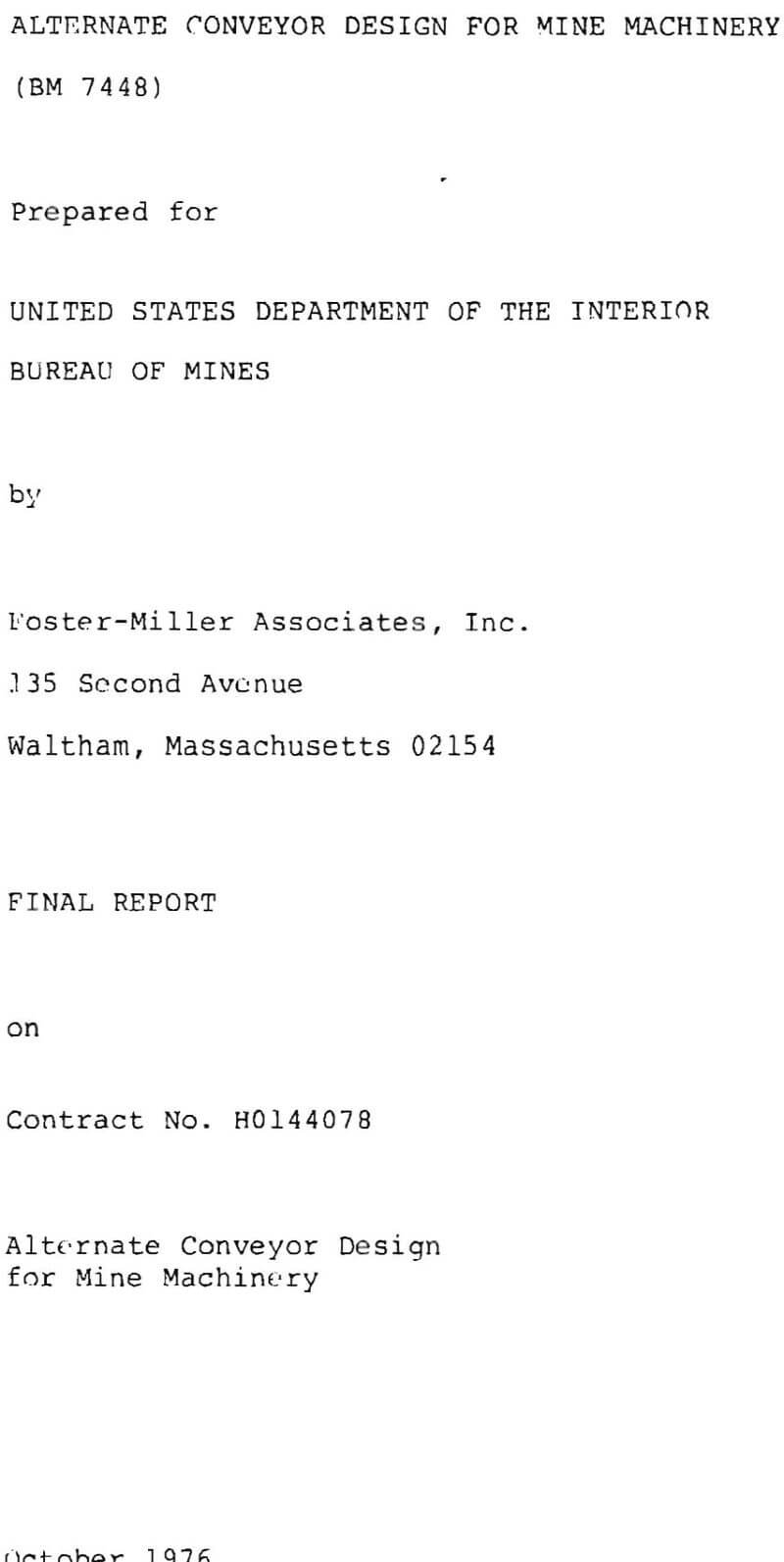Table of Contents
It does not appear likely that this conveyor-system function requirement can be avoided. The emphasis on the continuous miner performance is necessarily such that the conveyor system must be required to handle any material that is provided by the cutting head. Hence, a slowing down in the rate of advance of the miner to produce more finely cut coal and rock cannot be permitted. Similarly, stopping the miner operation to remove oversize material by other means would be unsafe as well as uneconomical.
This functional requirement has a significant influence on the design constraints of the conveyor system. Any potentially applicable concept must have the capability to perform this function if it is to be considered suitable for the continuous miner. However, the loading machine does not present this severe requirement, which means that an optimum system developed for the miner will probably be overdesigned for the loader application. Since there are potential alternatives to the chain conveyor loading machines, such as belt conveyor loaders, the continuous miner presents the more significant problem. The conveyor development discussed in this report is aimed toward this application.
Foster-Miller Associates was awarded a contract by the Bureau of Mines to develop a new conveyor system which can be adapted to existing machinery (continuous miners and loading machines) to reduce the noise from the conveyor to 90 dBA without reducing the performance of the machinery. The work leading to the demonstration of a prototype conveyor system was divided into three phases;
(a) Initial design and component testing
(b) Fabrication of a new conveyor
(c) Testing and demonstration of system in an operating situation.
It was originally planned to conduct the Phase I component testing on a simple test stand constructed around standard conveyor components. However, the drastic change in availability of miner and loader parts prevented the required hardware from bring obtained. Fortunately, Peabody Coal Company offered to lend a Joy 14BU10-41CH loader for use during the entire program, including the Phase I component testing. The loader was subsequently brought to the Foster-Miller facilities in Waltham, Massachusetts and was subjected to testing and modification.
The scope of the Phase I study included initial design and component testing to ensure that the system designed would meet the conveyor operating requirements. The recommended design was presented in the Phase I Report, and incorporates the following main features:
- The recommended design consists of a main conveyor and a tail conveyor.
- The main conveyor incorporates a full-width rubber belt running between the chain/flights and the bed plate. The rubber belt turns around an idler roller mounted immediately behind the foot sprocket shaft.
- The tail conveyor, which is a simple rubber belt conveyor design, is mounted on a turntable bearing that is attached to the main conveyor by means of a cantilever bracket.
This report presents the detailed conveyor system as installed on the loader, including modifications incorporated during the field test program. Furthermore, it discusses the surface and underground testing, presents and discusses the test results, and provides recommendations for further developments.
Summary
The new conveyor system was designed and installed on a Joy 14 BU10-41CH loading machine provided by Peabody Coal Company for the test program. The modified loader is shown in Figures 1 to 1. Figure 1 shows the loader operating at the Peabody Spur Mine. Figure 2 is a front view of the machine and shows the rubber belt mounted under and moving with the flight chain. Figure 3 is a side view of the swing conveyor. Figure 4 is a rear view of the machine and shows the conveyor system and transfer point. Figure 5 is a schematic of the machine showing all modifications that affect the noise level of the conveying system.
Following conveyor fabrication and installation on the Joy loader at FMA, the machine was shipped to M.A.T. Industries, West Frankfort, Illinois, for installation of a canopy, system debugging, and surface testing as requested by U.S. Bureau of Mines prior to underground testing in the Spur Mine, Boonville, Indiana. Repairs and modifications to the conveyor design resulted from these preliminary tests which involved operation of the loader in a surface coal pile at the M.A.T. facilities.
After approximately 20 hours of surface testing, the loader was taken underground at the Spur Mine for testing in an operating section. The underground testing was only partly successful. The Joy loader was too large to maneuver easily in the 16 foot wide by 50 to 53 inch high entries. The canopy restricted visibility of the gathering arms. Left side entries became inaccessible as a result of pinching of the coal seam. There was excessive coal spillage at the transfer point preventing shuttle cars from tramming up to the loader. This latter problem was eventually traced to slippage of the tail- conveyor-belt drive pulley on its shaft which reduced the belt speed, and caused the belt conveyor to be incapable of taking sufficient coal away from the transfer point. For these reasons the underground testing was curtailed.
The underground test conditions also showed the hydraulic fluid reservoir to be inadequate, which resulted in abnormal motor and pump noise levels.
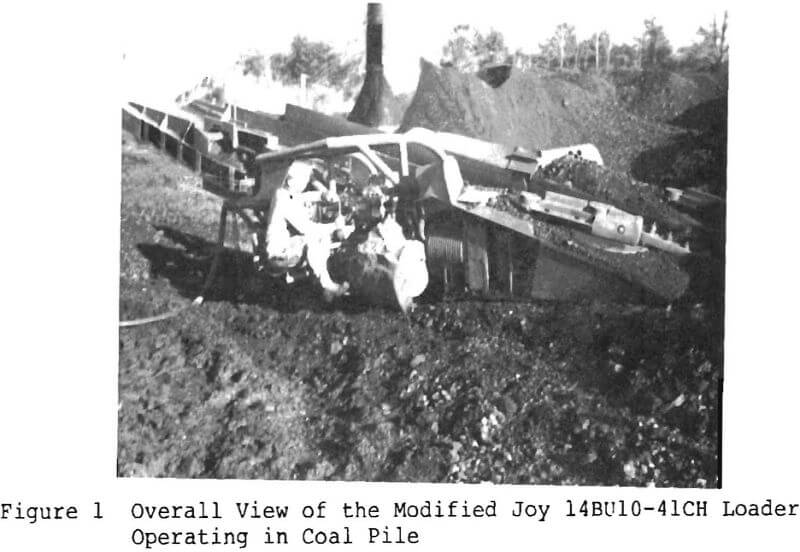

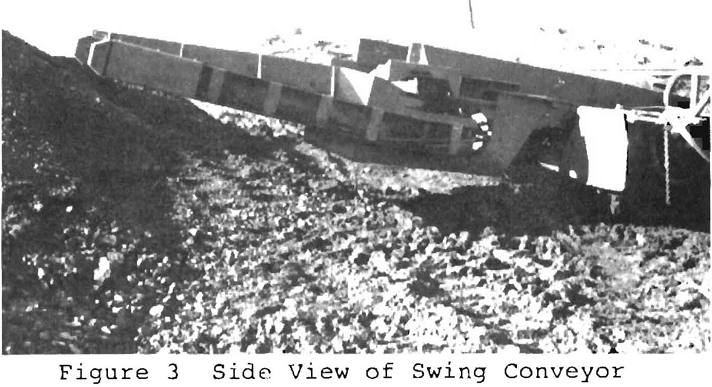
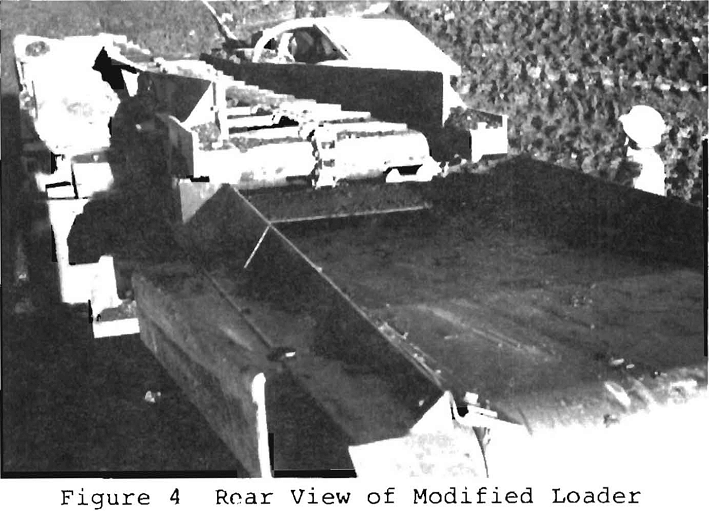
The major results of the testing program are summarized below:
(a) Noise levels measured at the operator’s ear were between 92 dBA and 99 dBA during surface tests and between 91 dBA and 102 dBA during underground tests depending on type of operation. Measurements of the loader running empty tended toward the higher noise levels. These measurements, after modifications, compare with empty running noise levels of 108 to 110 dBA at the operator’s position measured before loader modifications.
(b) The rubber belt under the chain and flights on the main conveyor of the loader performed satisfactorily during the testing period. Some belt damage sustained during surface testing was caused by excessive chain tension. Proper tension eliminated this damage. However, mine personnel were not convinced that the belt would hold up under prolonged service. The moving rubber belt contributed 1-2 dBA of quieting.
(c) The rubber-covered return guide idler, the rubber mounting pads for pillow blocks, and the rubber cover on the flight chain return bed contributed the remainder of quieting achieved, which was the greatest part.
(d) Although system coal loading capability underground was not demonstrated equal to the capability of the unmodified loader, the deficiency is attributable to belt drive roll slippage, which was an equipment malfunction rather than a design limitation resulting from the modifications to the design. In addition, the loader was operated within a lower coal seam than that suited for the particular loader used. Quantitative measurement of loading rates was not performed.
(e) Unexpectedly high noise from a hydraulic motor and pump were experienced. The apparent cause of this excess noise was an inadequate fluid reservoir.
The following future envelopments of the conveyor system are recommended:
(a) For application to loading machines, the flight chain may be eliminated and the main conveyor belt driven by the foot or tail pulley. Significant additional noise reduction is possible with this approach if attention is paid to noise generation by the gathering arms, motors, and hydraulic pumps. The height of the transfer section from the front to the mining conveyor may be significantly reduced in this way, making the loader potentially applicable to low coal machines.
(b) For continuous miners, where the flight chain must be retained, significant quieting may be obtained by relatively simple modifications including the addition of a rubber-covered return guide idler, rubber mounting pads for pillow blocks, and a rubber cover on the flight chain return bed. These changes are possible without changing the overall height of a miner.
(c) Future investigations into reduction of chain pitch are recommended. A major source of noise energy is the “chordal action” of the chain as it passes over a sprocket. Because the chain forms a polygon around the sprocket rather than a circle, there are fluctuations in effective sprocket radius resulting in chain speed and tension fluctuations and a tendency for the chain to slap surfaces adjacent to its path. Reduction of chain pitch permits more links to wrap on a given size sprocket, thereby reducing chordal action.
Conveyor Design
Main Frame (Joy Loader)
The conveyor main frame consists of a reworked Joy 14 BU10-41CH loader provided by Peabody Coal Company for use during the test program. This machine has a 38-inch wide conveyor belt and a 2½ inch pitch x 3 inch flight chain.
The following modifications were made to the loader. (See Drawing No. 11484 and Figure 5.)
(a) The swing conveyor portion of the loader was removed, and a new tail pulley combination was added (Figure 6).
(b) The major structural modification to the loader is a cantilever bracket welded to the main frame. This bracket is the main support for the swing conveyor, as shown in Drawing No. 20133.
(c) A rubber conveyor belt was mounted between the flight chain and the main frame conveyor bed. The flight chain rides on the belt while on the top bed plate of the conveyor. As the flight chain turns around at the tail roller (Figure 6), the conveyor belt rides on the flights through the main frame return bed to within 2 inches of the chain drive sprocket. There, an idler pulley, inserted in the conveyor bed, turns the belt back onto the conveyor bedplate as the flight chain is pulled around the drive sprocket and back on top of the rubber belting, as shown in Figure 7. To eliminate material buildup between the bed plate and the conveyor belt, holes were drilled in the top bed plate along the length of the main frame conveyor.



(d) In conventional conveyor configurations, the flight chain passes around the tail roller and onto the return bed, striking the leading edge of the bedplate as it returns toward the drive sprocket, in the foot section. To eliminate this impact, the new configuration includes an energy-absorbing pulley which is mounted in front of the return bed, as shown in Figure 8. This causes the flight chain to be carried upward past the leading edge of the return bedplate and onto the rubber cover which is bolted to the leading edges of the bedplates of the main frame and the foot section.
Swing Conveyor
The Swing Conveyor consists of a roller bed, drive idler, pulleys, a rubber belt, a 24 HP hydraulic drive motor, a turntable bearing, and a double-acting swing cylinder. See Drawing No. 20133 and Figure 5.
(a) The 25 HP hydraulic motor drives a pulley at the tail end of the Swing Conveyor.
(b) The conveyor belt rides on a roller bed in order to reduce belt drag, as shown in Figure 9.
(c) The conveyor belt is protected underneath from shuttle car abuse by means of a deflector plate running from the drive roller to within 18 inches of the cantilever bracket (Figure 10). The portion of the conveyor which lies under the main conveyor tail pulley, the point at which the coal is dumped by the flight chain onto the swing conveyor, is fitted with a deflector plate to protect the conveyor rollers from loading impact (Figure 6). The deflector plate also allows easier swing conveyor start-ups (less torque requirement) when coal still remains on the unit.
(d) The double-acting cylinder is used to pivot the swing conveyor to the right and left, as shown in Figures 11 and 12. The swing conveyor is mounted on the turntable bearing which, in

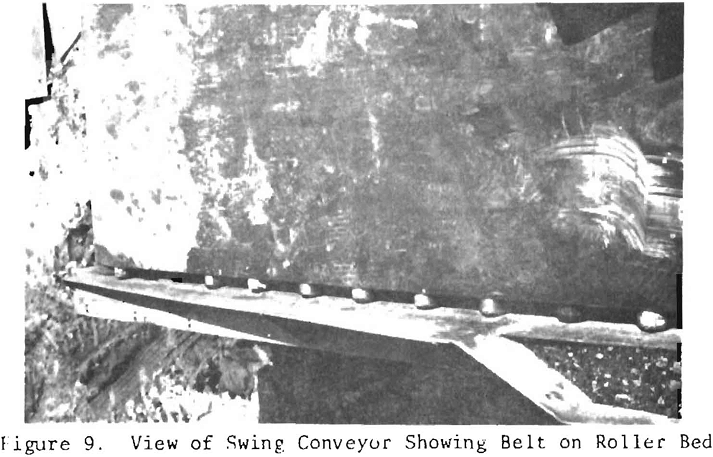
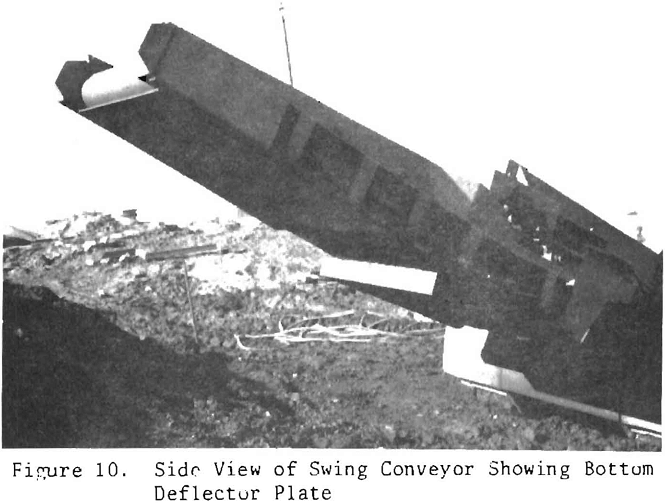

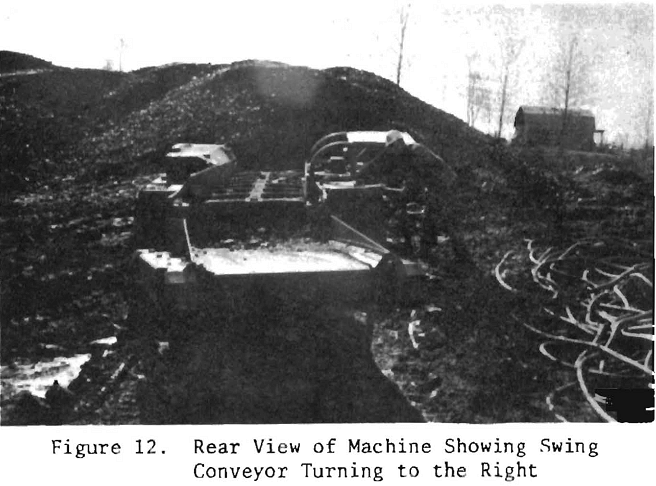
turn, is mounted on the cantilever bracket. The maximum angle of conveyor swing is 40 degrees, as compared to 45 degrees for the original loader.
(e) The swing conveyor, being mounted on the cantilever bracket, is an integral part of the main frame. Hence, it is raised and lowered in the same manner as a conventional conveyor system.
Hydraulic Drive System
The Joy loader hydraulic power supply consists of a 10 HP electric motor, a gear pump, and a 24 gallon reservoir. This system is used to raise the foot section and main frame (tail section) hydraulic jacks. It also supplies power to the swing cylinder, which moves the tail section right or left. The pressure requirements of the conventional system are less than 1000 psi.
The swing conveyor belt drive hydraulic motor requires 3000 psi pressure so the 10 HP electric motor and pump were replaced by a 40 HP electric motor and a 3000 psi dual hydraulic pump, as shown schematically in Figure 13. One pump supplies the belt drive motor at 3000 psi pressure, and the other supplies the cylinders described above.
The larger motor and pump were mounted externally against the reservoir at the operator’s position, as shown in Figure 14.
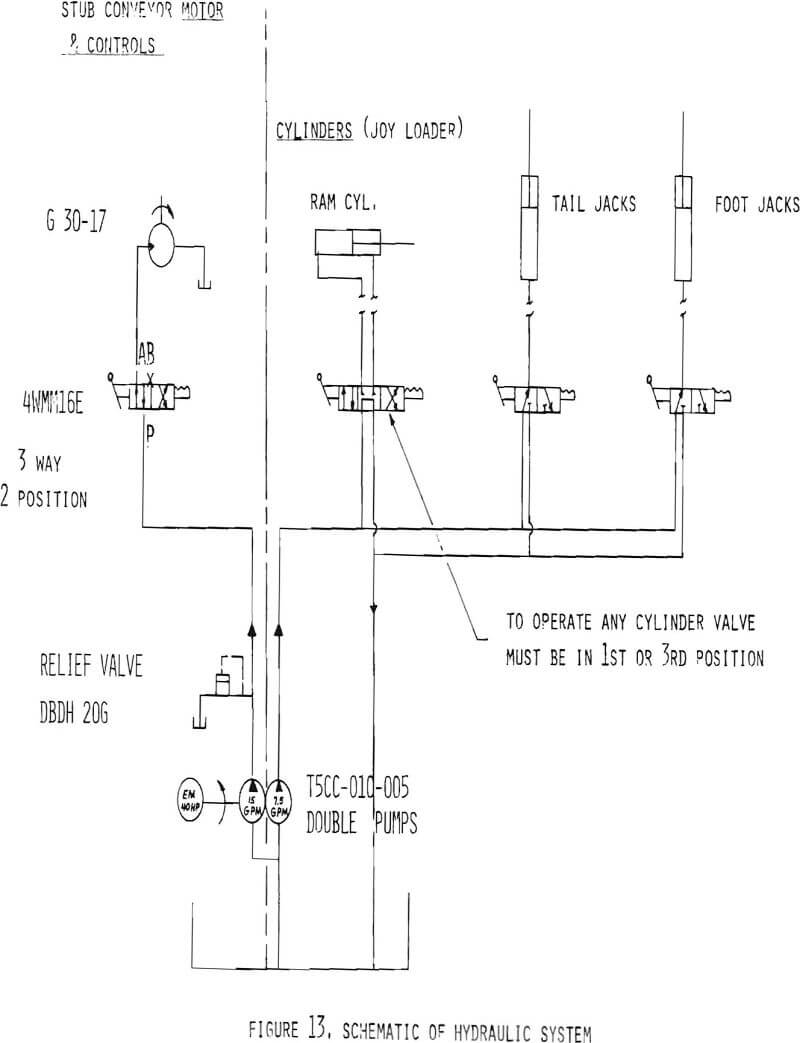

Test Program and Results
The fabrication and installation of the new conveyor design on the Joy loader were performed at the Foster-Miller Associates facilities in Waltham, Massachusetts, and by local subcontractors. The loader was then shipped to M.A.T. Industries in West Frankfort, Illinois, for installation of a canopy and methane monitor, and preliminary performance testing prior to the underground test program in the Peahody Spur Mine. However, at the recommendation of the Bureau of Mines and Peabody Coal Company, this was extended into a rather comprehensive surface testing program, in which the loader operated in a surface coal pile. The surface and underground test programs are both described in the following sections.
Surface Testing
The surface testing program was conducted in a coal pile outside the M.A.T. Industries facilities, as shown in Figure 15. The total operating time of the conveyor system at this site, including the initial conveyor and loader debugging, was approximately 20 hours.
The machine debugging became a considerably greater undertaking than was originally projected. This was partly due to the condition of the loader. Four hydraulic cylinders, were replaced. The drive motor for the hydraulic system was rewired. The loader tracks, and miscellaneous other components were repaired.
A separate, major problem was the inadequate power of the tail conveyor hydraulic motor to drive the tail conveyor belt under conditions of maximum loading. Figure-16 illustrates the amount of coal on the conveyor system that lead to this failure. This problem was solved by increasing the pressure in the hydraulic line driving the motor, and mounting a series of small diameter rollers underneath the conveyor belt to reduce friction between the belt and the bedplate


An apparently minor, but persistent problem, was the buildup of coal on top of the main conveyor bed plate, between the bed plate and the conveyor belt. At the beginning of the surface testing program, this buildup was sufficient to cause excessive tension in the conveyor chain, which in turn stalled the conveyor. Two methods for eliminating this problem were tried. First, a snowplow scraper was installed on top of the belt, within the return bed, and immediately following the rubber covered return idler. Next, an array of holes was drilled in the bod plate along the length of the main frame conveyor. The snowplow scraper was not effective, but the holes in the bed plate reduced the buildup significantly, by providing scraping edges against the belt and permitting any captured coal dust to pass through.
Following the successive incorporation of these repairs, modifications, and improvements, the loader was tested for several additional hours prior to shipment to the Spur Mine.
A one-day surface testing program in a coal pile at the Spur Mine was also conducted at the completion of the underground testing in order to obtain additional noise measurements.
The results of the performance evaluations and acoustic measurements conducted during the surface testing program are discussed in Sections 4.3 and 4.4.
Underground Testing
The underground test program was conducted in the Peabody Spur Mine, near Boonville, Indiana. This is a new mine which enters the coal seam at the base of a 60-foot high wall of the old Squaw Creek strip mine. The coal seam is the Illinois No. 5 seam, and ranges in thickness from approximately 50 inches to more than 65 inches.
Seven main entries have been driven past an area where six submains have been turned and are now being driven. The entries are generally 20 feet wide on 50 foot centers, both inby-outby and left to right. However, during the time the underground test program was conducted, bad roof conditions had been encountered, requiring a limitation on entry width to 16 feet. Furthermore, the coal seam had pinched down to approximately 50-53 inches in the working section.
The limited entry height and width resulted in rather adverse operating conditions for the modified Joy 14 BU10-41CH loader, which is approximately 11 feet wide, 28 feet long, and 45 inches high. The top of the canopy was lowered to 48 inches to avoid jamming it against the roof, and consequently, the loader operator was unable to see the gathering arms and the conveyor foot section. This lack of operator visibility presented problems in clean-up work and in loading the shuttle cars.
Following approximately 23 hours of loader operation in the mine, the coal seam at the left side of the working section pinched down even more, preventing the loader from moving up to that working face. The decision was then made, in consultation with the Bureau of Mines, to terminate the underground testing program and the loader was taken outside.
The results of the performance evaluations and acoustic measurements conducted during the underground testing program are discussed in the two following sections.
Conveyor Performance
Following the modification of the tail conveyor during the surface testing program, the conveyor system performed very well, and was able to discharge coal satisfactorily even at the highest rates of loading attempted in the surface coal piles.
Towards the end of the underground testing program, during the visit by the Bureau of Mines representative, a problem with spillage became apparent at the transfer point from the main conveyor to the tail conveyor, caused by the inability of the tail conveyor to move as much coal as the main conveyor.
When the loader was moved out of the mine shortly afterwards, it was discovered that the tail conveyor drive pulley was slipping on the drive shaft, causing the tail conveyor to operate at part speed.
The rubber belt under the conveyor chain on the main conveyor had been the subject of some concern. This belt, which is not independently powered, but is driven by the friction between it and the conveyor chain, typically travels at approximately one half the speed of the flight chain. On examining the belt following the surface testing at M.A.T. Industries, it was found that no significant wear had been caused by coal and rocks, but some damage had occurred to the strip of belt riding under the conveyor chain. This was probably caused at the tail roller, where the chain moves relative to the belt while turning around a small radius.
To minimize the damage to the new belt installed for the underground testing, the flight chain takeup tension was reduced. The flight chain may have been excessively tensioned during the surface testing. Final examination of the belt indicated that this was successful, as shown in Figure 17. The belt is scuffed and scraped from contact with the flights, coal, and the conveyor chain but the damage is contained within 1/32 inches of the surface, and in no place has the fabric ply been damaged by shearing or impact.
We believe, however, that belt wear would be even further reduced if the belt traveled at the same speed as the flight chain. Hence, we recommend that a belt drive be incorporated into future versions of this system.
An additional modification that should be considered would consist of replacing the steel tail roller on the main conveyor with a roller covered by an approximately one-inch layer of hard rubber (70-80 durometer). This would reduce possible belt damage by the flight chain.
The return idler and the rubber belt placed over the main conveyor return bed also performed satisfactorily. Some belt damage at the leading edge of the return bed occurred during the surface testing, when the return idler was mounted sufficiently low that the conveyor chain hit against this edge. This problem was eliminated by raising the return idler approximately ½ inch.
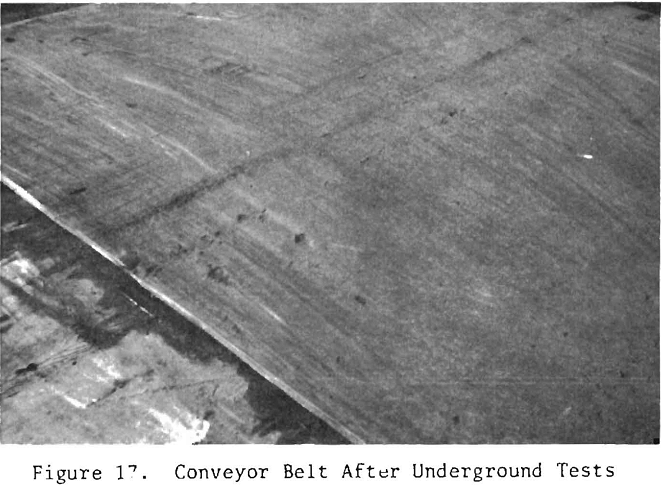
The holes drilled in the top bed plate to eliminate coal buildup under the conveyor belt were quite effective in reducing this problem to a manageable level. However, it is believed that the coal buildup can be further reduced by installing the snowplow scraper immediately adjacent to the foot section idler pulley rather than back by the rubber-covered return idler. By this means, the conveyor belt would be scraped clean of coal dust just before it turns around the idler pulley and onto the top of the bed plate.
The swing conveyor belt showed a tendency to ride over to one side while turned and loading, particularly when the conveyor was raised, causing the conveyor belt to ride on a transverse slope. This problem was minimized by maintaining proper belt adjustment and belt tension which, however, did not fully eliminate occasional scraping of the belt against the side of the conveyor. No measurable belt damage was apparent or is expected by this failure to track properly, but the problem can probably be alleviated by installing tracking idlers along the sides of the conveyor belt.
Noise Measurements
The noise levels at several positions around the loader were measured during the surface and underground test programs. Measurements were made at the operator’s ear, at approximately one foot from the side of the loader by the gathering arms, at the transfer point from the main to the stub conveyor, and at the end of the stub conveyor. Measurements were made with the conveyors running empty and fully loaded with coal. Table I presents a summary of the noise levels obtained during the test programs. Under the most advantageous operating conditions, the noise levels at the operator’s ear were approximately 93 dBA and 95 dBA, respectively, on the surface and during underground testing.
Some problems were encountered with auxiliary loader components. The noise level at the operator’s ear due to the motor and hydraulic pump (Figure 14) was found to vary from 89 to 94 dBA, resulting in
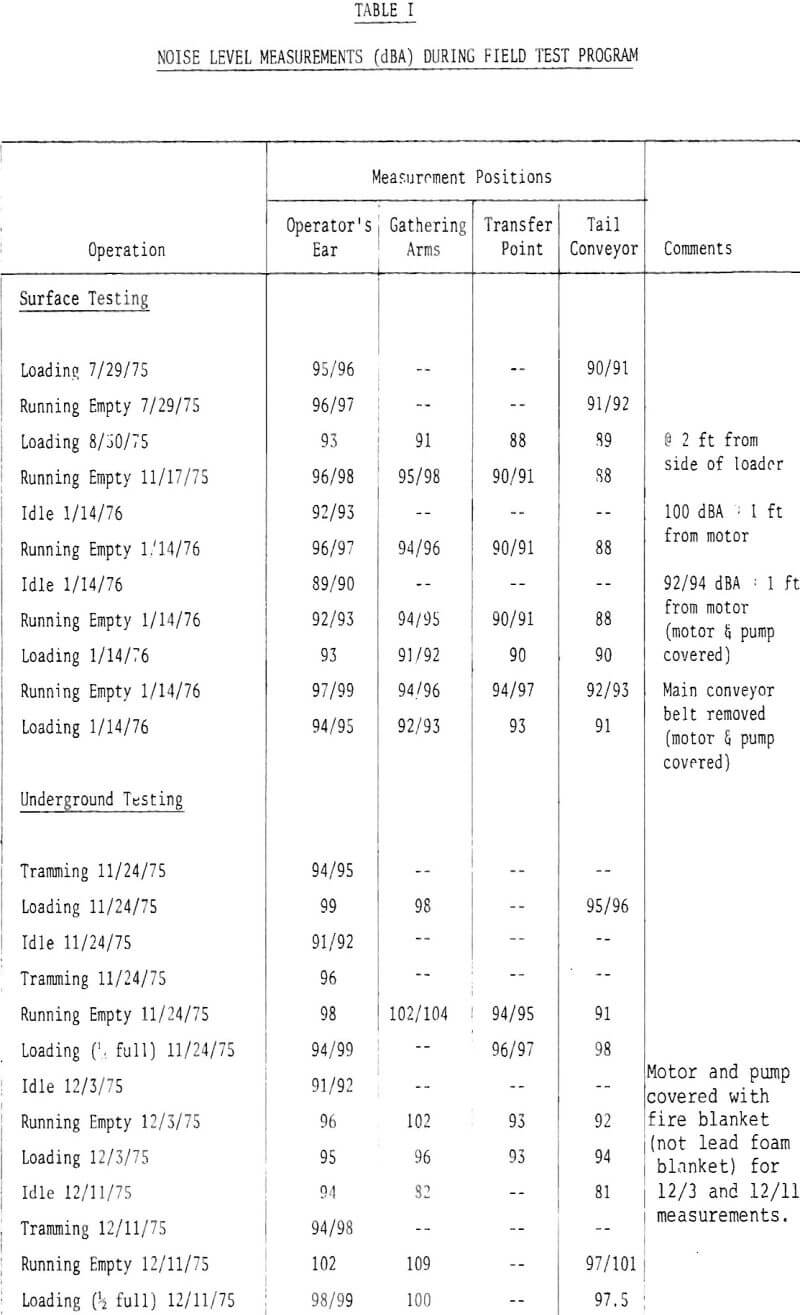
noise levels (when running empty) which varied from 93 to 98 dBA. The cause of this variation was eventually diagnosed as an inadequate hydraulic fluid supply tank. With the conveyor frame or the foot section in a raised position, the extended hydraulic lift cylinders drained the supply tank to the extent that hydraulic fluid passing through the pump contained an excessive amount of air. This caused an uneven loading on the hydraulic pump vanes and dynamic imbalance of the pump and motor shafts, resulting in higher noise levels. During the final surface testing, a lead foam blanket was wrapped around the motor and pump, as shown in Figure 18. The corresponding noise level readings at the operator’s ear were 89/90 dBA due to the hydraulic pump only, 92/93 dBA with the conveyor running empty, and 93 dBA with the conveyor loading. The increased noise level while loading was presumably caused by coal scraping against the conveyor side plates, and by coal discharging from the main to the stub conveyor at the transfer point and from the end of the stub conveyor.
Table IIA shows that significant quieting of the loader, by about 15 dBA, was achieved by the modifications made. Table IIB is shown to illustrate the wide variations in noise measurements resulting from both changes in operating condition and changes in sensor location. The conventional Joy 14 BU10 (low machine) is a smaller loader and inherently less noisy than the 14 BU10-41CH modified under this contract, but the data indicate a similarly broad range of noise measurements with similar correlation to operating condition and sensor location.
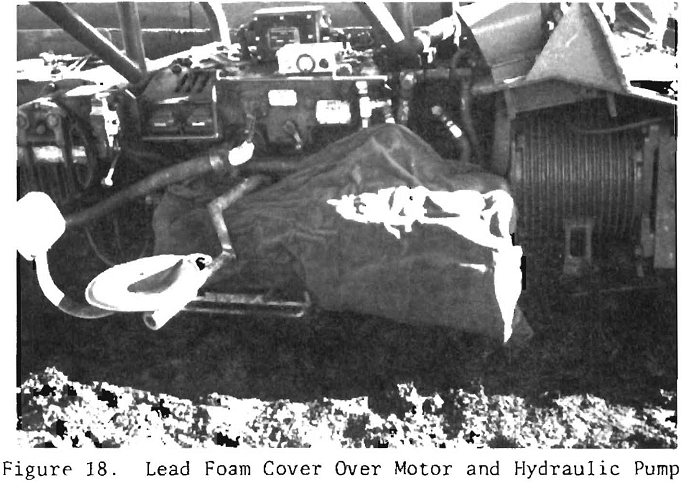

Conclusions and Recommendations
The objective of this program was to develop a new conveyor system that could be adapted to existing continuous miners and loading machines and would exhibit a noise level of 90 dBA from the conveyor without reducing the performance of the machinery.
(a) The measured noise levels at the operator’s ear were 92/93 dBA at the surface and 95/96 dBA underground. The modification to the particular loader of this program reduced noise levels by approximately 15 dBA.
(b) During surface testing, the conveyor system performed without apparent reduction in loading capacity. Capacity reductions observed in underground tests are attributable to mechanical failure (belt drive pulley slippage on its shaft) and to mine dimensions not well suited to the design of the particular machine used. The conveyor design modifications developed in this program can be applied to moderate or high coal. The vertical dimension of the transfer point presents a limit to applications in low coal.
(c) The durability of a rubber belt under chains and flights was not adequately tested because of the short duration of operating tests. Some belt damage was caused by the chain during the surface tests due to excessive chain tension. With lower chain tension, underground tests showed no additional wear.
(d) The rubber-covered return guide idler, the rubber cover on the flight chain return bed, and the rubber mounting pads for the sprocket and roller pillow blocks were successful in terms of reduced noise levels and showed no wear in the limited testing time available. These features are worthy of note because, besides providing effective quieting, they may be incorporated into a conventional swing conveyor machine with only minor alteration. The quieting achieved by the main belt, although measurable, was significantly less.
The following recommendations for design improvement are the result of experience with the design developed in this program:
(a) The design criteria for loaders and continuous miners are sufficiently diverse that future attempts at quieting conveyors should consider these applications individually.
(b) A conveyor system for loading machines might eliminate the flight chain from the front conveyor, using belts only. The major noise contributor then would be the gathering arms which could be the target of another effort. By eliminating chains and flights, the height of the transfer point may be reduced by about 6 inches, thus making a machine suited for lower coal seams. There are indications from this program that a belt can adequately resist wear in this application.
(c) A conveyor system for continuous miners, which requires the use of chains and flights, may best be quieted by incorporating the rubber-covered return guide idler, the rubber cover on the flight chain return bed, and the rubber mounting pads for the sprocket end roller blocks. The incorporation of a moving belt under the chain and flights is not recommended. The quieting achieved by this method, though measurable, is not justified by the complexity of the modification.
(d) Future effort to mechanically quiet conveyors should emphasize redesign of chains and flights to permit the shortest possible chain pitch to be used. The shorter the pitch the greater will be the number of sprocket teeth at a given pitch diameter. The fluctuations in chain pitch line velocity (chordal effect) are inversely proportional to the number of sprocket teeth. These velocity fluctuations are the major source of vibration input at a sprocket and resultant chain slap.
General Arrangement Drawings and Cost Estimate
The approximate cost for a conveyor modification as tested would be, including materials and direct labor costs, approximately $18,000. Following is a breakdown of these costs based on the test unit fabricated for this program. This compares with a cost of approximately $500 to provide rubber pads for pillow blocks, a rubber-covered steel shaft and mounting at the return end of the main conveyor and belting applied to the return bed plate. Drawings 11484 and 20733, Sheets 1 and 2, illustrate the configuration built and tested.

Note: These cost estimates are based on prices as of December, 1974. Appropriate forward pricing factor should be applied to these estimates for current equivalent.

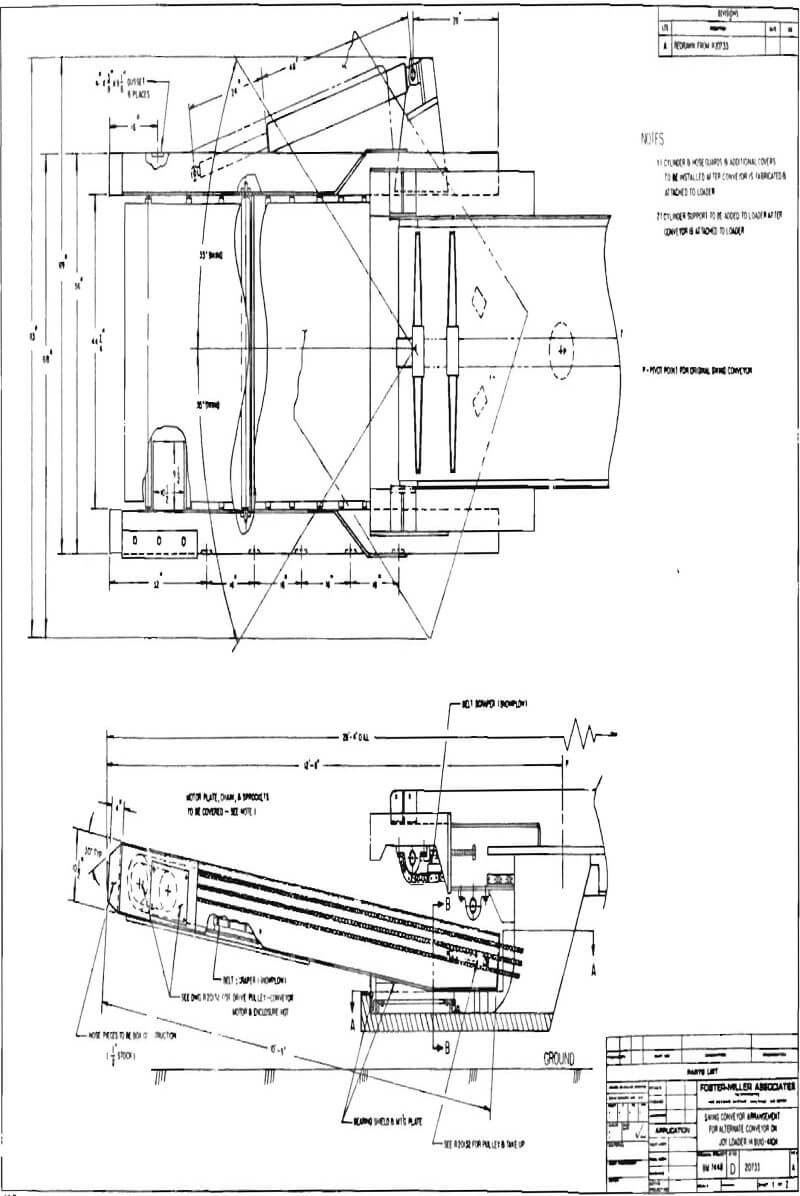

Appendix A
Alternate Conveyor Design For Mine Machinery Phase I Report
Introduction and Background
The Bureau of Mines is seeking improvements in all elements of underground coal mining. The subject element concerns quieter conveyors for continuous miners and loaders.
Noise measurement studies conducted in underground coal mines have shown that several mine occupations expose individuals to noise levels that result in shift noise exposures in excess of the safe standards established by the Walsh Healey criteria. In particular, operators of continuous miners and loading machines are subjected, during loading, to noise levels ranging from 89 to 108 dBA. The principal sources of noise on these machines are in the chain conveyor system. Efforts to date to eliminate or reduce the conveyor noise have been conducted along modifications of the existing mechanical system. An alternate approach is to use a new conveyor design to reduce noise levels without reducing the performance of the machine.
Foster-Miller Associates has been awarded a contract by the Bureau of Mines to develop a new conveyor system which can be adapted to existing machinery (continuous miners and loading machines) to reduce the noise from the conveyor to 90 dBA without reducing the performance of the machinery. The work leading to the demonstration of a prototype conveyor system has been divided into three phases;
(a) Initial design and component testing.
(b) Fabrication of new conveyor.
(c) Testing and demonstration of system in an operating situation.
This report presents the results achieved during the Phase I effort.
Summary
The basic objective of this program is to develop a new conveyor system which can be adapted to continuous miners and loaders to reduce the noise from the conveyor to 90 dBA without reducing the performance of the machinery.
The scope of the Phase I study included initial design and component testing to ensure that the system designed meets ail the operating requirements. This report presents the results of the component testing and the conveyor design, significant aspects of which arc listed below:
- The recommended conveyor design will result in a noise level at the operator’s position of 87.5 to 90.5 dBA in a free field environment, and 90.5 to 93.5 dBA in the mine environment.
- The recommended design consists of a main conveyor and a tail conveyor.
- The main conveyor incorporates a full-width rubber belt running between the chain/flights and the bed plate. The rubber belt turns around an idler roller mounted immediately behind the foot sprocket shaft.
- The tail conveyor, which is a simple rubber belt conveyor design, is mounted on a turn table bearing that is attached to the main conveyor by means of a cantilever bracket.
- Personnel from Joy Manufacturing Co. expressed the opinion that the rubber belt conveyor should have acceptable performance and durability, since Joy used to build a loader for hard rock mining that incorporated a straight rubber belt conveyor system.
Technical Discussion
Conveyor Concepts
The purpose of the conveyor system on a continuous miner or loading machine is to transport the coal from the base region to the material handling system behind the machine. In the case of a loading machine the capability of the conveyor system to transport the design load is a necessary and sufficient design consideration, i. e., any conveyor concept which can satisfy the transport requirement is a potential candidate for the conveyor system.
For the continuous miner, however, there are additional performance requirements that must be taken into consideration. Since the currently used chain conveyor system is such a sturdy device, which can suffer a great deal of abuse and still remain operational, the practice has developed to use the conveyor as a rock and coal breaker as well as a transport system. For example, if the cutting head breaks off a large piece of rock or coal from the mining face, the gathering arms will push it onto the conveyor chute, and the flights will move it along the chute until, if it exceeds the critical size, it will become wedged between the chute and the cutting head boom. According to current miner operation practice, the flights will continue to move, breaking off and grinding down the material until it has been reduced sufficiently in size to pass through the restriction. If the material is wedged in sufficiently well to stall the chain drive, the conveyor is engaged in reverse long enough to free the flights, after which another attempt is made to crush the rock.
It does not appear likely that this conveyor system functional requirement can be avoided. The emphasis on the continuous miner performance is necessarily such that the conveyor system must be required to handle any material that is provided by the cutting head. Hence, a slowing down in the rate of advance of the miner to produce more finely cut coal and rock cannot be permitted. Similarly, stopping the miner operation to remove oversize material by other means would be unsafe as well as uneconomical.
This functional requirement has a significant influence on the design constraints of the conveyor system. Any potentially applicable concept must have the capability to perform this function if it is to be considered suitable for the continuous miner. However, the loading machine does not present this severe requirement, which means that an optimum system developed for the miner will probably be overdesigned for the loader application. Since there are alternatives to the chain conveyor loading machines, we believe that the continuous miner presents the more significant problem and have aimed our concept development toward this application.
The following conveyor concepts were either presented in the Technical Proposal or have been considered during the program:
(a) Dual Semi-Elastic Belt Concept. This concept was presented in the Technical Proposal, and considers two semi-elastic belts, capable of 45 degree horizontal turns, running between the conveyor bed plate and the chains and flights.
Although similar types of belts are currently being used in face haulage conveyor systems, we concluded that the technical risk of this approach, particularly with respect to belt durability, was too high to warrant further consideration.
(b) Dual Belt Support Concept. This concept, also presented in the Technical Proposal, differs from the previous one mainly in that the belts do not permit horizontal turns. Instead, a separate belt conveyor mounted aft of the fixed belt/chain conveyor provides the 45 degree turning capability.
This concept was considered and tested quite thoroughly during the program, but as it permitted the conveyor chain to impact on the bed plate between the two belts, it did not achieve the noise reduction objectives.
(c) Single Full-Width Belt Concept. This concept is very similar to that presented above, except that a single, full-width belt runs between the chains and flights and the bed plate. At the foot end, the belt runs on an idler roller mounted immediately behind the drive sprocket roller on which the chain and flights run. At the tail end, the belt and chain/flights turn around a common idler roller.
This concept has been shown to be quite successful. It achieved the noise reduction objectives and appears promising in terms of durability and resistance to operational abuse. A more detailed description of this concept follows in Section 4.
Test Configuration
We had originally planned to conduct the Phase I component testing on a simple test stand constructed around standard conveyor components. However, the recent drastic change in availability of miner and loader parts prevented us from obtaining the required hardware. Fortunately, Peabody Coal Company offered to lend us a Joy 14BU10-41CH loader for use during the entire program, including the Phase I component testing. The loader was subsequently brought to the Foster-Miller facilities in Waltham, Massachusetts and has been subjected to testing and modification.
The Joy loader is stationed outdoors adjacent to the Foster-Miller workshop, as shown schematically in Figure 1. During baseline and subsequent acoustic tests, measurements have been taken at the following positions, as indicated in Figure 1.

- Operator’s Position
- Foot Shaft Sprocket
- Tail Shaft
- Aft Edge of the Conveyor Return Bed
- Conveyor Side Plate.
These positions were chosen daring the baseline testing, as the corresponding conveyor components were determined to constitute major sources of noise.
Due to the proximity of the loader to the wall, the measured acoustic data will not correspond to hemispherical face field measurements. In particular, the measured values at the operator’s position will be from 3 to 6 decibels higher than the corresponding free field values. The three dB uncertainty arises because of the distributed noise source with varying spectrum characteristics.
The conversion from free field values to the mine environment also embodies some uncertainty, as it depends on the mine passage reverberation characteristics. Generally, however, we consider that the direct field and the reverberant field are of equal intensity at a distance of 5 to 10 ft from a machine placed in a mine entry. Hence, a conservative estimate is obtained by assuming that the noise level at the operator’s position is 3 dB higher than the corresponding free field value.
Test Results
Table- I presents a summary of the noise levels measured during the program, at the measurement positions identified in Figure 1. The baseline measurements served to identify the dominant sources of noise. A series of modifications were implemented on this configuration to determine the noise reduction potential, as identified in Table I. It is apparent that the rubber belt approach gave promising results.
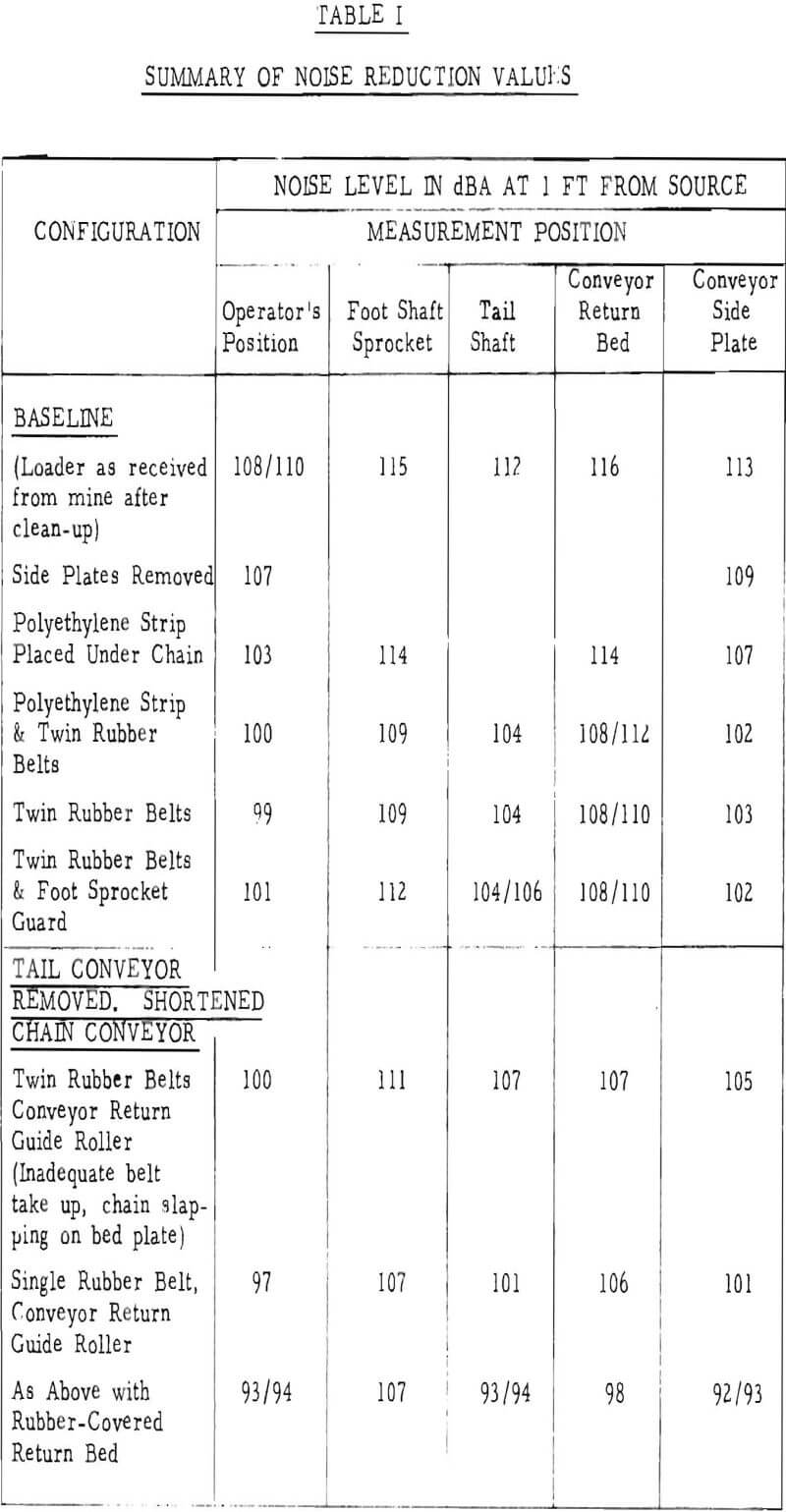
On this basis a new conveyor configuration was fabricated, consisting of a non-turning, shortened chain conveyor with rubber belts between the chain/flights and the bed plate. This configuration initially incorporated twin rubber belts and a spring-loaded tail shaft, but acoustic measurements showed that noise generation due to the belt slapping on the bed plate was excessive. This problem was removed by going to a single, full-width rubber belt which turned around a separate idler roller mounted immediately behind the foot sprocket roller. A substantial noise reduction resulted. Finally, the excessive noise generation by the chain/flights slapping against the return bed plate was eliminated by running the flights on guide strips mounted on a rubber belt within the return bed duct. Significant additional noise reduction resulted.
The final recommended configuration has a measured noise level at the operator’s position of 93.5 dBA. This corresponds to a free field noise level of 87.5 to 90.5 dBA, and a noise level in the mine environment, at the operator’s position, of 90.5 to 93.5 dBA.
Recommended Design
Our final recommended design, the development and component testing of which has been discussed in the preceding sections, is shown schematically in Figure 2. Detailed design information is given in three separate drawings which are attached to this report;
- Main Conveyor (Drawing 11484)
- Swing Conveyor (Drawing 20133)
- Swing Conveyor Drive (Drawing R20132)
The main conveyor incorporates a full width rubber belt which runs, between the chain/flights and the conveyor bed plate. In addition, it includes a separate idler roller for the belt, mounted immediately behind the foot sprocket roller, a fixed tail shaft takeup arrangement, an idler roller guiding the chain/flights into the return bed, and guide strips /isolators mounted in the return bed.
We have considered the question of belt durability in the mine environment. Prolonged running of the conveyor during the component testing produced no signs of wear. Furthermore, we have recently been made aware that Joy Manufacturing Co. used to build a loader for use in hard rock mining that incorporated a straight rubber belt conveyor.
The tail conveyor is a simple rubber belt conveyor design, driven by a hydraulic motor. The conveyor is mounted on a turntable bearing that is attached to the main conveyor frame by a cantilever bracket. We have paid particular attention to specifying standard, off-the-shelf components in the conveyor design in order to avoid delivery problems during the fabrication phase.
